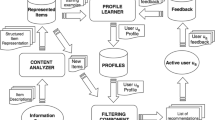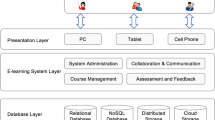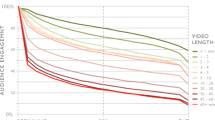Abstract
e-Learning industry is rapidly changing and the current learning trends are based on personalized, social and mobile learning, content reusability, cloud-based and talent management. The learning systems have attained a significant growth catering to the needs of a wide range of learners, having different approaches and styles of learning. Objects delivered by these systems should provide a variety of learning content to satisfy different learners and should also have a pedagogical value than simple course content to empower learning. The Knowledge Objects of Knowledge Management Systems can be combined and delivered with existing Learning Objects of Learning Management System to provide better and more holistic user experience. Choosing a suitable object in accordance with learner category is a complex task. The paper encompasses data mining approach, fuzzy clustering technique to combine Learning and Knowledge objects based on attributes of metadata. These objects are further mapped with various learning styles and an appropriate set of objects are delivered to the learners. Thus, a personalized and more authentic learning experience is achieved emphasizing the content reusability.






Similar content being viewed by others
References
Agbonifo, Adewale, & Alese. (2012). Design of a Neurofuzzy-based Model for Active and Collaborative Online Learning. Unpublished PhD Thesis, Federal University of Technology, Akure. 7–8.
Agbonifo & Catherine O. (2013). Fuzzy C-means clustering model for identification of Students’ Learning Preferences in Online Environment. International Journal of Computer Applications & Information Technology 4(1) October-November 2013 (ISSN: 2278-7720).
Agyei, D. D., & Keengwe, J. (2014). Using technology pedagogical content knowledge development to enhance learning outcomes. Education and Information Technologies, 19(1), 155–171.
Alian, M. (2011). Formalization and implementation of Eliminating and Optimizing Selection (EOS) approach. Education and Information Technologies, 16(1), 89–103.
Anderson, T. & Elloumni, F. (2004). Theory and practice of online learning. Athabasca: Athabasca University Press. URI: http://hdl.handle.net/2149/411.Available http://cde.athabascau.ca/online_book/.
Atif, Y., Benlamri, R., & Berri, J. (2003). Learning objects based framework for self-adaptive learning. Education and Information Technologies, 8(4), 345–368.
Balki, S. R. (2010). Learning management system. USA: Lambert Academic Publishing. ISBN: 3838361687.
Barcelos, C., Gluz, J., & Vicari, R. (2011). An agent-based federated learning object search service. Interdisciplinary Journal of e-Learning and Learning Objects, 7(1), 37–54.
Bezdek, J. C. (1981). Pattern recognition with fuzzy objective function algorithms. Kluwer Academic Publishers.
Biletskiy, Y., Baghi, H., Keleberda, I., & Fleming, M. (2009). An adjustable personalization of search and delivery of learning objects to learners. Expert Systems with Applications, 36(5), 9113–9120.
Castro, F., Vellido, A., Nebot, À., & Mugica, F. (2007). Applying data mining techniques to e-learning problems. In Evolution of teaching and learning paradigms in intelligent environment (pp. 183–221). Springer Berlin Heidelberg.
da Silva, P. F., & Mustaro, P. N. (2009, October). Clustering of learning objects with Self-Organizing Maps. In Frontiers in Education Conference, 2009. FIE’09. 39th IEEE (pp. 1–6). IEEE.
De Santiago, R., & Raabe, A. (2010). Architecture for learning objects sharing among learning institutions—LOP2P. IEEE Transactions on Learning Technologies, 3(2), 91–95.
Dunham, M. H. (2003). Data mining: introductory and advanced topics, Prentice-Hall.
Dunn, J. C. (1973). A fuzzy relative of the ISODATA process and its use in detecting compact well-separated clusters. Journal of Cybernetics, 3, 32–57.
Entwistle, N. (1988). Motivational factors in students’ approaches to learning. In Learning strategies and learning styles (pp. 21–51). Springer US.
Felder, R. M., & Brent, R. (2005). Understanding student differences. Journal of Engineering Education, 94(1), 57–72.
Felder, R.M. (1993). Reaching the second tier: learning and teaching styles in college science education. Journal of College Science Teaching 23(5) 286–290. www.ncsu.edu/felderpublic/Papers/Secondtier.html.
Gallenson, A., Heins, J., & Heins, T. (2002). Macromedia MX: creating learning objects. White paper. San Francisco: Macromedia. Available at: http://download.macromedia.com/pub/elearning/objects/mx_creating_lo.pdf.
Graf, S., & Liu, T. C. (2008). Identifying learning styles in learning management systems by using indications from students' behaviour. In Advanced Learning Technologies, 2008. ICALT’08. Eighth IEEE International Conference on (pp. 482–486). IEEE.
Griffith, R. (2003). Learning objects in higher education. Academic Advanced Distributed Learning Co-Lab publication, University of Wisconsin (April 2003), http://www.academiccolab.org/resources/webct_learningobjects.pdf.
Hager, P. (2004). Lifelong learning in the workplace? Challenges and issues. Journal of Workplace Learning, 16(1/2), 22–32.
Han, J., Kamber, M., & Pei, J. (2006). Data mining, southeast Asia edition: concepts and techniques. Morgan kaufmann.
Hanna, M. (2004). Data mining in the e-learning domain. Campus Wide Information Systems, 21(1), 29–34.
Hodgins, H. W. (2002). The future of learning objects. Available at : http://dc.engconfintl.org/ cgi/viewcontent.cgi?article = 1012&context = etechnologies.
Hogo, M. A. (2010). Evaluation of e-learners behaviour using different fuzzy clustering models: a comparative study. arXiv preprint arXiv:1003.1499.
Horton, W. (2001). Developing knowledge products, Bolder, CO.William Horton Consulting.
Horton, W. (2006). E-learning by design. San francisco: Pfeiffer.
Hwang, G. J. (1999). A knowledge-based system as an intelligent learning advisor on computer networks. In Systems, Man, and Cybernetics, 1999. IEEE SMC’99 Conference Proceedings. 1999 I.E. International conference on 2:153–158. IEEE.
Hwang, G. J. (2003). A test-sheet-generating algorithm for multiple assessment requirements. IEEE Transactions on Education, 46(3), 329–337.
Hwang, G. J., Huang, T. C. K., & Tseng, C. R. (2004). A group-decision approach for evaluating educational web sites. Computers & Education, 2004, 65–86.
IEEE LTSC (2002). Learning Technology Standards Committee (LTSC) IEEE Standard for Learning Object Metadata. 1484.12.1-2002. http://ltsc.ieee.org/wg12/.
Ilukwe, A. N., & Biletsky, Y. (2014). Hybrid search and delivery of learning objects system. Journal of Computer Science, 10, 906–924.
Jones, M. K. (1990). Domain knowledge representation for instructional analysis. Educational Technology, 30(10), 7–32.
Kaufman, L., & Rousseeuw, P. J. (2009). Finding groups in data: an introduction to cluster analysis (Vol. 344). John Wiley & Sons.
Keefe, J. W. (1979). Learning style: an overview. Student learning styles: diagnosing and prescribing programs. 1–17.
Klemke, R., Ternier, S., Kalz, M., & Specht, M. (2010). Implementing infrastructures for managing learning objects. British Journal of Educational Technology, 41(6), 873–882.
Kolb, D. A. (1984). Experiential learning: experience as the source of learning and development..
Macpherson, A., Elliot, M., Harris, I., & Homan, G. (2004). e-Learning: reflections and evaluation of corporate programmes. Human Resource Development International, 7(3), 295–313.
Magolda, M. B. B. (2001). A constructivist revision of the measure of epistemological reflection. Journal of College Student Development, 42(6), 520–34.
Magolda, Baxter, M.B., & Porterfield, W.D. & American Coll. Personnel Association, Washington, DC. (1988). Assessing Intellectual Development the Link between Theory and Practice. ACPA Media Publication No. 47. [Washington, D.C.] : Distributed by ERIC Clearinghouse.
Manouselis, N., Drachsler, H., Vuorikari, R., Hummel, H., & Koper, R. (2009). A sneak preview to the chapter recommender systems in technology enhanced learning. In Proceedings of the 3rd International Workshop on Social Information Retrieval for TEL (p. 535).
Margo, H. (2004). Data mining in the e-learning domain. Computers & Education, 42(3), 267–287.
Merrill, M. D. (1999). Instructional Transaction Theory (ITT): instructional design based on knowledge objects. Instructional Design Theories and Models a New Paradigm of Instructional Theory, 2, 397–424.
Metros, S. et. al. (2003). Learning objects ontology. NLII learning objects working group. http://people.cohums.ohiostate.edu/dagefoerde2/NLII_LO/ontology/ontology.htm.
Monk, D. (2005). Using data mining for e-learning decision making. The Electronic Journal of e-Learning, 3(1), 41–54.
Montazer, G. A., & Fatemeh, G. (2011). Grouping in e-leaming environment using evolutionary fuzzy clustering approach. International Journal of Information and Communication Technology, 3(1), 9–19.
Moore, W. S. (1988). The measure of intellectual development: An instrument manual. Olympia: Center for the Study of Intellectual Development.
NSDL(National Science Digital Library)OAI data provider information under services and tools, https://wiki.ucar.edu/display/nsdldocs/OAI±Data±Provider.
Ochoa, X., & Duval, E. (2008). Relevance ranking metrics for learning objects. IEEE Transactions on Learning Technologies, 1(1), 34–48.
Raghuveer, V., & Tripathy, B. (2012). An object oriented approach to improve the precision of learning object retrieval in a self learning environment. Interdisciplinary Journal of E-Learning and Learning Objects, 8(1), 193–214.
Ruffner, J., & Deibler, N. (2008). Knowledge objects and learning objects: birds of a feather or different species altogether. Proceedings of the Inter service /Industry Training, Simulation & Education Conference (I/ITSEC), Orlando, FL
Sabitha, A. S., & Mehrotra, D. (2012a). User centric retrieval of learning objects in LMS. In Computer and Communication Technology (ICCCT), 2012 Third International Conference on (pp. 14–19) IEEE.
Sabitha, A. S., Mehrotra, D., & Bansal, A. (2012b). Quality metrics a quanta for retrieving learning object by clustering techniques. In Digital Information and Communication Technology and it’s Applications (DICTAP), 2012 Second International Conference on (pp. 428–433). IEEE.
Sabitha, A.S, Mehrotra, D., Bansal (2014a). Enhanced learning by extending metadata of learning objects with knowledge objects. International Journal of Education and Learning 3(1), 1–12. http://dx.doi.org/10.14257/ijel.2014.3.1.01.
Sabitha, S.A., Mehotra, D., Bansal, A., (2014b). Similarity Based Convergence of Learning Knowledge Objects and Delivery Using Agglomerative Clustering. Journal of Information Technology and Application in Education 3(1), March 2014 doi: 10.14355/jitae.2014.0301.02.
Sabitha, S., Mehrotra, D., & Bansal, B. (2014c). A data mining approach to improve re-accessibility anddelivery of learning knowledge objects. Interdisciplinary Journal of E-Learning and Learning Objects, 10, 247-268. Retreived from http://www.ijello.org/Volume10/IJELLOv10p247-267Sabitha0874.pdf.
Salehi, M., Kamalabadi, I. N., & Ghoushchi, M. B. G. (2014). Personalized recommendation of learning material using sequential pattern mining and attribute based collaborative filtering. Education and Information Technologies, 19(4), 713–735.
Shen, L. P., & Shen, R. M. (2004). Learning content recommendation service based-on simple sequencing specification. In Advances in Web-Based Learning–ICWL 2004 (pp. 363–370). Springer Berlin Heidelberg.
Smith, R. S. (2004). Guidelines for authors of learning objects. New Media Consortium. http://mevlana.inet-tr.org.tr/nmc/NMC%20LO%20Guidelines.pdf.
Snae, C., & Brüeckner, M. (2007). Ontology-driven e-learning system based on roles and activities for Thai learning environment. Interdisciplinary Journal of E-Learning and Learning Objects, 3(1), 1–17.
Stathacopoulou, R., Magoulas, G. D., & Grigoriadou, M. (1999). Neural network-based fuzzy modeling of the student in intelligent tutoring systems. In Neural Networks, 1999. IJCNN’99. International Joint conference on 5, 3517–3521. IEEE.
Štuikys, V., & Damaševičius, R. (2007). Towards knowledge-based generative learning objects. Information Technology and Control, 36(2), 202–212.
Talavera, L., & Gaudioso, E. (2004). Mining student data to characterize similar behavior groups in unstructured collaboration spaces. In Workshop on artificial intelligence in CSCL. 16th European conference on artificial intelligence (pp. 17–23).
Tan, P. N., Steinbach, M., & Kumar, V. (2006). Introduction to data mining (Vol. 1). Boston: Pearson Addison Wesley.
Tang, T., & McCalla, G. (2005). Smart recommendation for an evolving e-learning system: architecture and experiment. International Journal on E-learning, 4(1), 105–129.
Thalmann, S. (2014). Adaptation criteria for the personalized delivery of learning materials: a multi-stage empirical investigation. Australasian Journal of Educational Technology, 30(1), 45–60.
Tsai, C. J., Tseng, S. S., & Lin, C. Y. (2001). A two-phase fuzzy mining and learning algorithm for adaptive learning environment. In Computational Science-ICCS 2001 (pp. 429–438). Springer Berlin Heidelberg.
Tsai, K. H., Chiu, T. K., Lee, M. C., & Wang, T. I. (2006). A learning objects recommendation model based on the preference and ontological approaches. In Advanced Learning Technologies, 2006. Sixth International Conference on (pp. 36–40). IEEE.
Valsamidis, S., Kontogiannis, S., Kazanidis, I., & Karakos, A. (2011). E-learning platform usage analysis. Interdisciplinary Journal of E-Learning and Learning Objects, 7(1), 185–204.
Wagner, E. (2002). Steps to creating a content strategy for your organization. e-Learning Developers’ Journal. ELearning Guild. Retrieved from: http://www.elearningguild.com/pdf/2/102902MGT-H.pdf.
Wiley, D.A. (2000). Connecting learning objects to instructional design theory: a definition, a metaphor, and a taxonomy. The instructional use of learning objects retrieved from: http://reusability.org/read/chapters/wiley.doc.
Yen, N. Y., Shih, T. K., Chao, L. R., & Jin, Q. (2010). Ranking metrics and search guidance for learning object repository. IEEE Transactions on Learning Technologies, 3(3), 250–264.
Yordanova, K. (2007). Meta-data application in development, exchange and delivery of digital reusable learning content. Interdisciplinary Journal of E-Learning and Learning Objects, 3(1), 229–237.
Zakrzewska, D. (2008). Using clustering technique for students’ grouping in intelligent e-learning systems (pp. 403–410). Springer Berlin Heidelberg.
Zouaq, A., Nkambou, R., & Frasson, C. (2007a). Using a competence model to aggregate learning knowledge objects. In Advanced Learning Technologies, 2007. ICALT 2007. Seventh IEEE International Conference on (pp. 836–840). IEEE
Zouaq, A., Nkambou, R., & Frasson, C. (2007b). An integrated approach for automatic aggregation of learning knowledge objects. Interdisciplinary Journal of Knowledge and Learning Objects, 3, 135–162.
Acknowledgments
We acknowledge our sincere thanks to NSDL for allowing us to use their metadata harvested using OAI Data Provider form NSDL website. The NSDL publishes the metadata and is aggregated by an OAI provider which is open to the public. It helps in serving science, technology, engineering, and mathematics education.
Author information
Authors and Affiliations
Corresponding author
Appendices
Appendix I
Appendix II
Appendix III
Rights and permissions
About this article
Cite this article
Sabitha, A.S., Mehrotra, D. & Bansal, A. Delivery of learning knowledge objects using fuzzy clustering. Educ Inf Technol 21, 1329–1349 (2016). https://doi.org/10.1007/s10639-015-9385-5
Published:
Issue Date:
DOI: https://doi.org/10.1007/s10639-015-9385-5




